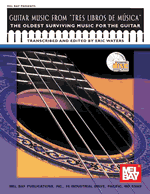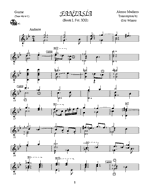Guitar Music from "Tres libros de música"
Click image to enlarge
Transcribed & edited by Eric Waters
1546. Forty-four years after the final voyage of Christopher Columbus, while the Spanish Conquistadors swept through the Americas, Alonso Mudarra published his Tres libros de música (Three Books of Music). These books, devoted primarily to music for the vihuela, also contain six pieces that are described by The New Harvard Dictionary of Music as
"the earliest printed music…" for the guitar.
In Guitar Music from Tres libros de música, George Washington University Instructor of Guitar, Eric Waters has transcribed and edited these six selections from the original four & one-half century old tablature. Each piece is presented both in standard musical notation and in a modern adaptation of the original tablature (with mensural rhythms printed above). Tablature and music are printed separately to eliminate page turns.
CD included. All selections recorded on a 1995 José Ramirez 1-A Tradicional Concert Guitar -650 mm / capo at third fret.
Available from:
Mel Bay Publications, Inc.
P.O. Box 66
#4 Industrial Dr.
Pacific, Missouri 63069-0066
Mel Bay Catalogue Number 99229BCD-Order Online
E-mail address: email@melbay.com
![]()
Classical Guitar Magazine (UK), October 2005:
This edition is in modern notation and also a tablature which uses modern six-line tablature with the lowest line as the 6th string with the halved mensural rhythmic values placed above, and the actual notes written numerically not alphabetically.
That said this little book whilst slim on content is beautifully set out and in rather large print although every piece fits onto two sides, so there are no page-turns here.
You find a useful three-page preface that encompasses many of the areas you might need to know about before embarking on the first piece, and at the end an index of edits where Waters has for one reason or another changed the original. As for the music there are four Fantasias, one Pavana and a Romanesca, with two of the fantasias necessitating a retuning of the 4th string to C as in the original instrument’s ‘old tuning’. The other four pieces are in the ‘new tuning’ which mimics our guitar’s string intervals.
So here then is a scholarly book with some interesting renaissance guitar music which so happens to come from the only surviving Mudarra manuscript and also interestingly is the oldest surviving music for the guitar. Certainly this little volume is at the very least worth having a look at. -- Chris Dumigan


